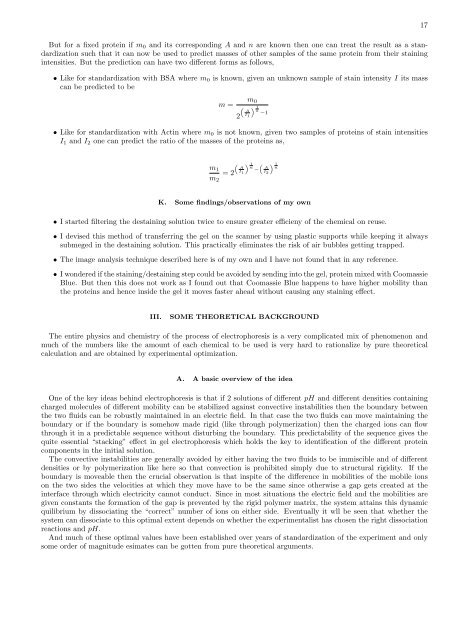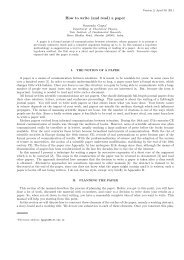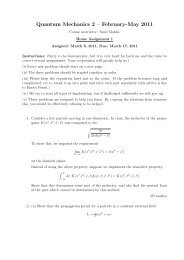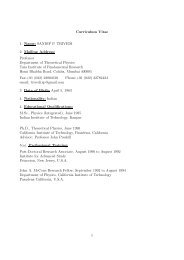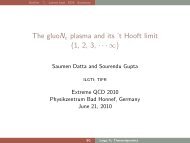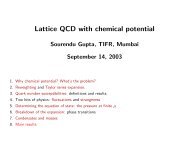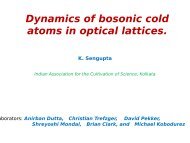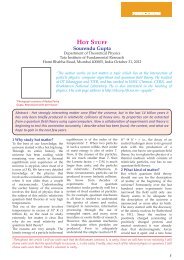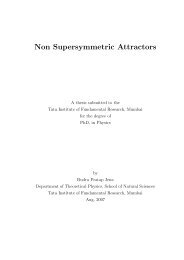A report on an experiment I did of doing electrophoresis with proteins
A report on an experiment I did of doing electrophoresis with proteins
A report on an experiment I did of doing electrophoresis with proteins
You also want an ePaper? Increase the reach of your titles
YUMPU automatically turns print PDFs into web optimized ePapers that Google loves.
But for a fixed protein if m 0 <strong>an</strong>d its corresp<strong>on</strong>ding A <strong>an</strong>d n are known then <strong>on</strong>e c<strong>an</strong> treat the result as a st<strong>an</strong>dardizati<strong>on</strong><br />
such that it c<strong>an</strong> now be used to predict masses <strong>of</strong> other samples <strong>of</strong> the same protein from their staining<br />
intensities. But the predicti<strong>on</strong> c<strong>an</strong> have two different forms as follows,<br />
• Like for st<strong>an</strong>dardizati<strong>on</strong> <strong>with</strong> BSA where m 0 is known, given <strong>an</strong> unknown sample <strong>of</strong> stain intensity I its mass<br />
c<strong>an</strong> be predicted to be<br />
m =<br />
2<br />
m 0<br />
“ ” 1<br />
A n<br />
I −1<br />
1<br />
• Like for st<strong>an</strong>dardizati<strong>on</strong> <strong>with</strong> Actin where m 0 is not known, given two samples <strong>of</strong> <strong>proteins</strong> <strong>of</strong> stain intensities<br />
I 1 <strong>an</strong>d I 2 <strong>on</strong>e c<strong>an</strong> predict the ratio <strong>of</strong> the masses <strong>of</strong> the <strong>proteins</strong> as,<br />
17<br />
m 1<br />
m 2<br />
= 2<br />
“<br />
A<br />
I 1<br />
” 1<br />
n<br />
−<br />
“<br />
” 1<br />
A n<br />
I 2<br />
K. Some findings/observati<strong>on</strong>s <strong>of</strong> my own<br />
• I started filtering the destaining soluti<strong>on</strong> twice to ensure greater efficieny <strong>of</strong> the chemical <strong>on</strong> reuse.<br />
• I devised this method <strong>of</strong> tr<strong>an</strong>sferring the gel <strong>on</strong> the sc<strong>an</strong>ner by using plastic supports while keeping it always<br />
submeged in the destaining soluti<strong>on</strong>. This practically eliminates the risk <strong>of</strong> air bubbles getting trapped.<br />
• The image <strong>an</strong>alysis technique described here is <strong>of</strong> my own <strong>an</strong>d I have not found that in <strong>an</strong>y reference.<br />
• I w<strong>on</strong>dered if the staining/destaining step could be avoided by sending into the gel, protein mixed <strong>with</strong> Coomassie<br />
Blue. But then this does not work as I found out that Coomassie Blue happens to have higher mobility th<strong>an</strong><br />
the <strong>proteins</strong> <strong>an</strong>d hence inside the gel it moves faster ahead <strong>with</strong>out causing <strong>an</strong>y staining effect.<br />
III.<br />
SOME THEORETICAL BACKGROUND<br />
The entire physics <strong>an</strong>d chemistry <strong>of</strong> the process <strong>of</strong> <strong>electrophoresis</strong> is a very complicated mix <strong>of</strong> phenomen<strong>on</strong> <strong>an</strong>d<br />
much <strong>of</strong> the numbers like the amount <strong>of</strong> each chemical to be used is very hard to rati<strong>on</strong>alize by pure theoretical<br />
calculati<strong>on</strong> <strong>an</strong>d are obtained by <strong>experiment</strong>al optimizati<strong>on</strong>.<br />
A. A basic overview <strong>of</strong> the idea<br />
One <strong>of</strong> the key ideas behind <strong>electrophoresis</strong> is that if 2 soluti<strong>on</strong>s <strong>of</strong> different pH <strong>an</strong>d different densities c<strong>on</strong>taining<br />
charged molecules <strong>of</strong> different mobility c<strong>an</strong> be stabilized against c<strong>on</strong>vective instabilities then the boundary between<br />
the two fluids c<strong>an</strong> be robustly maintained in <strong>an</strong> electric field. In that case the two fluids c<strong>an</strong> move maintaining the<br />
boundary or if the boundary is somehow made rigid (like through polymerizati<strong>on</strong>) then the charged i<strong>on</strong>s c<strong>an</strong> flow<br />
through it in a predictable sequence <strong>with</strong>out disturbing the boundary. This predictability <strong>of</strong> the sequence gives the<br />
quite essential “stacking” effect in gel <strong>electrophoresis</strong> which holds the key to identificati<strong>on</strong> <strong>of</strong> the different protein<br />
comp<strong>on</strong>ents in the initial soluti<strong>on</strong>.<br />
The c<strong>on</strong>vective instabilities are generally avoided by either having the two fluids to be immiscible <strong>an</strong>d <strong>of</strong> different<br />
densities or by polymerizati<strong>on</strong> like here so that c<strong>on</strong>vecti<strong>on</strong> is prohibited simply due to structural rigidity. If the<br />
boundary is moveable then the crucial observati<strong>on</strong> is that inspite <strong>of</strong> the difference in mobilities <strong>of</strong> the mobile i<strong>on</strong>s<br />
<strong>on</strong> the two sides the velocities at which they move have to be the same since otherwise a gap gets created at the<br />
interface through which electricity c<strong>an</strong>not c<strong>on</strong>duct. Since in most situati<strong>on</strong>s the electric field <strong>an</strong>d the mobilities are<br />
given c<strong>on</strong>st<strong>an</strong>ts the formati<strong>on</strong> <strong>of</strong> the gap is prevented by the rigid polymer matrix, the system attains this dynamic<br />
quilibrium by dissociating the “correct” number <strong>of</strong> i<strong>on</strong>s <strong>on</strong> either side. Eventually it wll be seen that whether the<br />
system c<strong>an</strong> dissociate to this optimal extent depends <strong>on</strong> whether the <strong>experiment</strong>alist has chosen the right dissociati<strong>on</strong><br />
reacti<strong>on</strong>s <strong>an</strong>d pH.<br />
And much <strong>of</strong> these optimal values have been established over years <strong>of</strong> st<strong>an</strong>dardizati<strong>on</strong> <strong>of</strong> the <strong>experiment</strong> <strong>an</strong>d <strong>on</strong>ly<br />
some order <strong>of</strong> magnitude esimates c<strong>an</strong> be gotten from pure theoretical arguments.


